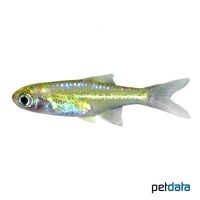Neon Green Rasbora (Microdevario kubotai)
| Neon Green Rasbora Microdevario kubotai | |
|---|---|
| Name | Neon Green Rasbora |
| Name Lat. | Microdevario kubotai |
| Synonym | Microrasbora kubotai |
| Family | Danios |
| Family lat. | Danionidae |
| Order | Carps |
| Order lat. | Cypriniformes |
| Origin | Thailand |
| Habitat | Streams, tributaries |
| Diet | Omnivore |
| pH | 6.0-7.0 |
| Behavior | Peaceful |
| Keeping | Swarm |
| Care Level | Difficult |
| Reproduction | Egg scatterer |
| Breeding | Difficult |
| Life Span | 2-3 years |
| Protection | No |
| Metric Units | |
| Size | 2 cm |
| Temperature | 22-27 °C |
| Hardness | 1-10 °dH |
| Aquarium | 50 l |
| US Units | |
| Size | 0.8" |
| Temperature | 72-81 °F |
| Hardness | 18-178 ppm |
| Aquarium | 15 gal |
Distribution and habitat
The neon danios are found exclusively (endemically) in the south of Thailand and in the adjacent Myanmar. There they live in the calm sections of oxygen-rich streams with a substrate of sand and stones, covered with roots, twigs and fallen leaves, and sometimes dense riparian vegetation.
Maintenance
The aquarium should have a dense border planting, with hiding and retreat possibilities (roots, stones) and offer sufficient swimming space. A dark substrate covered with some foliage (e.g. sea almond leaves), subdued light (floating plants) and soft, slightly acidic water is ideal. No ammonia, ammonium and nitrite should be detectable, the nitrate value should not exceed 100 mg/l. To ensure the water quality and oxygen content, a filter and heater adapted to the aquarium size is required, as well as lighting for the species-appropriate day-night rhythm of the animals.
Diet
In nature they feed on insect larvae, small crustaceans, algae and other zooplankton. The diet consists of small live foods such as daphnia, cyclops, artemia, mysis and mosquito larvae, which are also well accepted frozen, plus commercially available frozen special food mixtures, supplemented with a high-quality dry food (granules, flakes, micropellets) with high vegetable content (spirulina, kelp). A regular and varied diet promotes health and increases resistance. Only feed as much as is eaten immediately (in a maximum of 10 minutes).
Behaviour and compatibility
These very peaceful and shy schooling fish are not suitable for a community tank due to their small size. Ideal is the keeping in a species tank or together with other small fish species, like Boraras, Sundadanio, Trigonostigma etc.. Always a group of at least 10 animals, but better much more should be kept together. Basically, only compatible fish species with similar requirements to the water condition and water temperature may be socialized.
Sex dimorphism
The males are slimmer, smaller and more intensely colored than the more round-bellied females.
Reproduction and breeding
They are free spawners and spawn predators. The female spawns between fine plants (Java moss) near the bottom. The larvae hatch after about 72 hours and swim freely after 3-4 days.
Fry must be fed several times a day with special rearing food (Artemia nauplii, microworms, dust food). In a community tank breeding is hardly possible, because the spawn is easy prey.
Important
The foliage (sea almond tree, oak, etc.) not only provides cover, it enriches the water with humic substances, naturally lowers the pH and, as it rots, promotes the development of microorganisms that provide a valuable secondary food source.
The well-being of the fish should be monitored regularly. Temperature should be checked daily, pH, hardness and nitrate levels should be checked at least every 14 days. Regular partial water changes are recommended, even when contaminant levels have not yet reached the upper limit. Sudden changes in water quality should be avoided. Newly introduced fish must be accustomed slowly to the water in the aquarium.
Further literature can be found in your pet store.
References
Text: petdata; Image: petdata
Source: BMELV (1998): Tierschutzgutachten - Haltung von Zierfischen (Süßwasser); ENGELMANN (2005): Zootierhaltung - Tiere in menschlicher Obhut: Fische, Verlag Harri Deutsch
- Gemäß § 21 Abs. 5 Tierschutzgesetz idgF
